Free PDF download: Tab Sheet Music
Practise Backing Track:
Getting the tone:
This post covers Ed Sheeran’s “Thinking Out Loud” guitar solo section. The solo is originally by British studio guitarist Chris Leonard, and sounds like it was recorded on a strat/tele/some sort of single coil pickup guitar. That being said, I’ve played it on my ES-335 type guitar and it still sounded great. As for your amp and pedal setup, there is some slight break-up in the tone. This can be achieved through using a boost pedal that will cause natural break-up in your amp, or an overdrive/tube-screamer pedal (or lead channel of your amp) with the gain rolled pretty far down as well as your guitar’s volume being rolled down. The idea is to get your tone to clip more when the dynamics get a bit louder, yet keep things clean for the most part. More importantly, do what sounds good to your ears.
To find a qualified guitar instructor in the Montreal area visit guitar lessons Montreal.
Soloing approach:
The learn the Thinking out Loud guitar solo you need to know the following information. The song is in D major, and the solo has a lot of that John Mayer-y major pentatonic vibe to it and can serve as a great easy solo to introduce oneself into that genre of playing. The more familiar you are with your major pentatonic scale, the easier a time you’ll have with this solo. It will also be important that you’re familiar with the techniques used in this solo, such as bending, hammer-ons and pull-offs, and double stops. If you haven’t learned those techniques yet, (insert Thinking Out Loud Simplified.pdf here)
*here is a PDF of asimplified version of the solo*.
Playing the solo:
Bar 1:
Okay, onto the solo itself. The first bit of the solo is a pickup, right after the lyric “…where we are.” If you’re counting the beats in the measure, it comes between 3 and 4 (on the “and” of 3). The line is made up of multiple double-stops with hammer-ons on the lower notes. For example, you bar with your first finger the 7th fret of the A and D strings, but your 3rd finger will hammer on the note on the 9th fret of the A string only. Do the same thing on the 7th fret of the D and G strings and hammer on the 9th fret of D, and then bar the 7th fret of the G and B strings with your first finger to complete that pickup line.
Bar 2:
This bar consists of a double-stop bend. Your 4th finger is placed on the 10th fret of B, while your 3rd finger bends up on the 9th fret of G to make a full tone bend (sounds like 11th fret). Right after, release the bend coming back into position on the 9th fret, strumming both the G and B strings simultaneously. Finish this by simply playing 7-9-7 on the G string.
Bar 3:
Here we play two double-stop hammer-ons similar to what we did in the first bar, where we bar the 7th frets of the D and G string and hammer on the 9th fret of D. This is followed by the same line that was played in the first bar, with an extra strum on the last double-stop.
Bar 4:
This bar is another double-stop bend (same as in bar 2), but we will only play the top note (10th fret B string) a second time, followed by a release of the bend into a pull-off to the 7th fret (all on the g string). The rest is just repeating 9-7 on the G string.
Bar 5 & 6:
Bar 5 starts with a double-stop hammer-on, barring the 10th fret of the B and E string, hammer on the 12th fret of B with your 3rd finger two times, followed by a solitary note on the 10th fret of B. The end of the bar has a quick full bend on the 12th fret of E (making it sound like 14th fret E), followed by the 10th fret of E on the downbeat of bar 6, and then another quick full-tone bend on the 12th fret E.
Bar 7 & 8:
This bar is probably the most involved technically. You’re going to play the same double stop found in bar 5 three times, then a double stop of the 10th fret of B and E, followed by another double stop on the 12th fret B and 10th fret E. Next, a final double-stop using the 9th fret of G and the 10th fret of B, followed by a hammer-on and pull-off of 9-11-9 on the G string, sliding down to the 7th fret with your 1st finger. Bar 8 has you sliding with your 3rd finger from the 9th fret of G to the 11th fret, followed by a final note on the 10th fret of B.
Bar 8 – 10:
The conclusion to this solo is a series of descending double-stops in triplet rhythm (Counting triplets is just subdividing your beat into three eg: 1-and-a, 2-and-a, 3-and-a, etc…). Explaining this would be a bit too convoluted, so instead I encourage you to check out the tab and video and see what’s going on for yourself. The grouping of these double stops and be thought of as “and-a-1, and-a-2, and-a-3, and-a-4, and, 1”, meaning you play each double stop twice before the strong beat, and once more on the strong beat. Again, listening to the rhythm in the video will make more sense than my explanation.

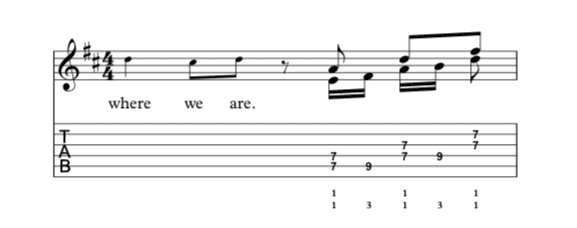
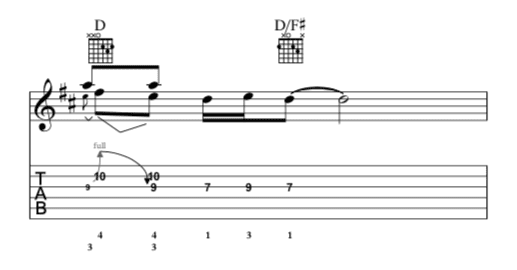
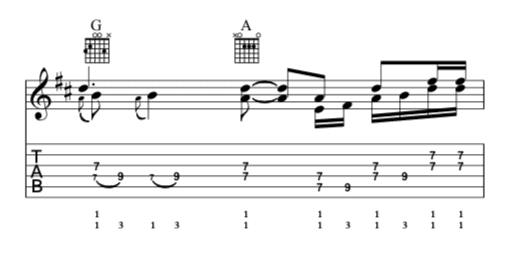
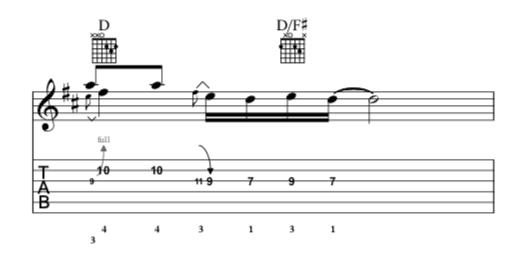
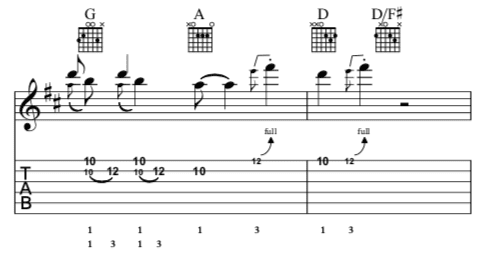
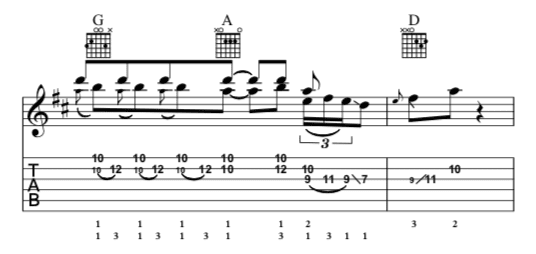
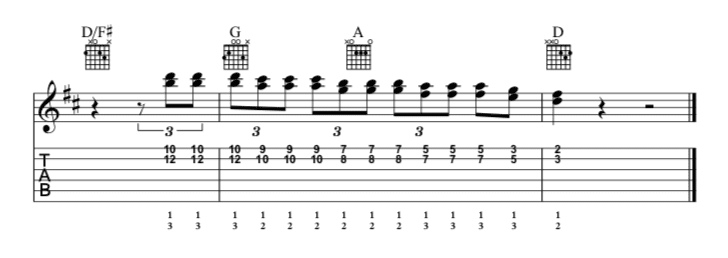


Great post, I believe people should larn a lot from this web blog its real user genial.